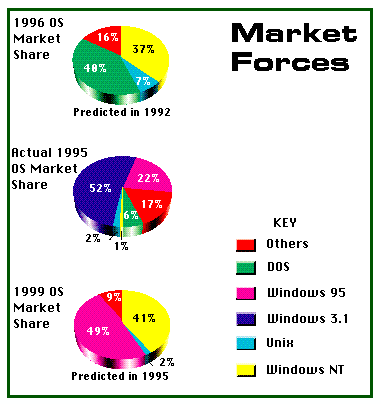| Without a doubt, at least some of NT's growth is coming
at the expense of Unix. We interviewed some technically
savvy users who have switched from Unix to NT, or who said
they might switch if they were reengineering their
installations today. Market research firms such as
Dataquest predict that NT will dominate the industry by
the turn of the century. Yet it's worth keeping in mind
that industry analysts and journalists made similar
predictions when Microsoft introduced NT in 1992, and NT's
adoption rate has fallen well short of expectations. NT's slow start is not surprising. Despite the computer industry's reputation for fast-paced change, fundamental shifts often happen at a glacial rate. It has been 11 years since Intel introduced the first 32-bit x86 processor (the 386), yet the vast majority of x86 users are just beginning to enter the 32-bit world of Windows 95 and Windows NT. Those inertial forces are even stronger at corporate sites where Unix and NT are battling head-to-head for the loyalty of MIS managers. You don't migrate an enterprise or even a departmental network onto a new OS overnight. That's probably why NT appears to be doing best at new sites that don't have to deal with major legacy issues. Meanwhile, Unix is hanging tight at larger companies that have already invested heavily in information technology. "While NT has slowed the growth of Unix — and has dampened it most at the uni- and quad-processor levels — Unix is still holding its own," says Pauline Mist, VP of Digital's Alpha server business. "We still see our Unix numbers going up quarter after quarter. Our midrange Unix boxes with Oracle have continued to set quarter-to-quarter sales records." Based on its own research and data from analysts, Digital forecasts that server business by revenue in the year 2000 will be 40 percent Unix, 40 percent NT, and 20 percent legacy systems (including MVS, OS/400, and OpenVMS). "But NT will by far dominate in unit numbers because it will come up from the desktop," says Mist. Market Share Comparisons and Predictions Yet by 1995 (middle figure), NT had obtained only 1 percent of the OS market, even less than Unix's 2-percent share. That doesn't stop predictions that by 1999 (bottom figure) Windows NT will have 41 percent of the market, while Unix is projected to have 2 percent. Copyright 1994-1998 BYTE |